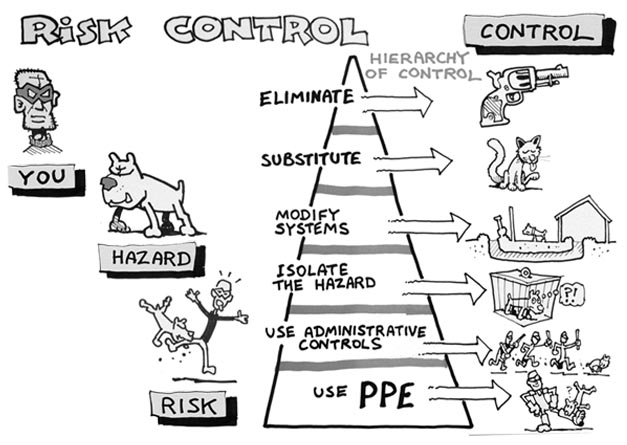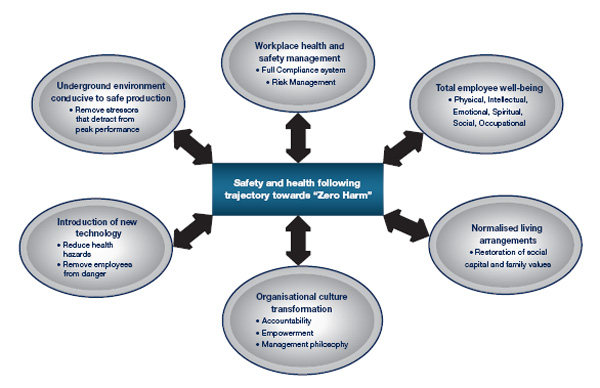By Koralia & Nicos Timotheou
It was not until the end of the nineteenth century that employee safety and health was acknowledged as the employer’s responsibility and was addressed as such by legislation. Prior to that, workers’ welfare was not an issue in the eyes of the law or of the society. However, as workers became more organised and as Trade Unions strengthened, in combination with the unacceptable conditions and numerous accidents in the mining industry, the first labour protecting legislation was effected in the 1880s. Since then, occupational safety and health has become a science in its own right and has gained the attention of public opinion, legislators, courts, employers and employees alike.
- What is Occupational Safety and Health?

While at work, employees are exposed to physical, chemical, biological, electrical, psychosocial and ergonomic hazards. These hazards may be present at the workplace or outside the workplace but still as a consequence of the job that needs to be done, including, for example, travelling for business purposes. Occupational hazards may threaten not only employees but other third parties such as suppliers, contractors, customers and the public. Based on the principle that “those who create the risk should manage it”, the employer is at all instances responsible to take action.
- So how can the employer act upon this?
The first step is to identify and list the hazards. There are many methodologies available: others by grouping the workplace by geographical area, others by breaking up the processes to procedures and then to activities, others by examining the exposure to each group of employees. All have their benefits and limitations and therefore a combination may be needed. What is important is that one covers thoroughly and consistently the entire operation, trying to identify all the potential hazards.
The second step is to undertake a risk assessment. For each hazard identified, the severity of impact must be established (i.e. the consequences), together with the probability of occurrence. The combination of these two parameters is the mostly preferred model, even though there are many risk assessment models that also include frequency and duration of exposure. It is important that for each hazard, the categories or job titles of the employees (or other parties) exposed are known. At the end of this step, a priority list of the risks to be addressed is produced.
As a third step measures are agreed to avoid or mitigate each risk or to protect from it. An implementation time plan is set. Measures are proportional to the risk, meaning that a high risk would justify a larger investment on measures and a higher urgency.
The second step is to undertake a risk assessment. For each hazard identified, the severity of impact must be established (i.e. the consequences), together with the probability of occurrence. The combination of these two parameters is the mostly preferred model, even though there are many risk assessment models that also include frequency and duration of exposure. It is important that for each hazard, the categories or job titles of the employees (or other parties) exposed are known. At the end of this step, a priority list of the risks to be addressed is produced.
As a third step measures are agreed to avoid or mitigate each risk or to protect from it. An implementation time plan is set. Measures are proportional to the risk, meaning that a high risk would justify a larger investment on measures and a higher urgency.

Finally, the implementation and effectiveness of the selected measures is monitored and each hazard is re-assessed until the associated risk becomes acceptable. Routine checks and audits as well as unannounced inspections are employed to ensure continuous implementation.
Needless to say, any amendments to pertinent legislation, infrastructure, equipment, materials, processes or peoples skills should trigger a review and possibly a reassessment of the affected hazards.
Training and awareness raising for all involved is imperative for the measures to be successful.
It may seem a tedious process but unless the operation is highly complex it is mostly common sense and planning that is needed.
Also, as occupational hazards always stem from the organization’s operation, reliance on the organization’s existing staff and expertise is usually sufficient to identify and assess the risks. Most of the times the users and operators are the best people to point out what types of problems may occur where they work. An experienced consultant can help catalyze the effective and efficient initial process set-up and certification training an Occupational Safety and Health Officer , who will thereafter take over.
It is again, as it has been stressed so many times before, a matter of building the right culture. In this case, it is a safety culture that puts humans first and operations second. A culture of mutual trust and respect between staff and management. It may be humanly impossible to make a workplace one hundred percent safe but it is expected that every employee exercises due diligence in trying to do so.
Once again, it is the manager’s duty (at all levels) to ensure that the sub-process of occupational risk management should be embedded in all business core and support processes!In today’s society of increased transparency, publicity, sensitivity to human rights and scrutiny to the accumulation of wealth by big enterprises, occupational safety and health is becoming a big issue.
Employers can no longer afford to ignore it:
- Legal fines, sentences of imprisonment and compensations to employees have increased exponentially;
- Due to the fierce competition in most industry segments, adverse publicity is now more damaging than ever;
- There is a moral duty of the employer to protect his or her employees from the hazards that his or her business creates; and last though by no means least,
- A sick, handicapped or dead workforce is much less productive than one that is alive and healthy!


